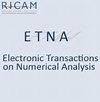改变你的s步GMRES中的s
IF 0.8
4区 数学
Q3 MATHEMATICS, APPLIED
引用次数: 0
摘要
Krylov子空间方法是求解大型稀疏线性系统的常用迭代方法,但在并行计算机上存在通信瓶颈。因此,已经开发了$s$步方法,其中逐个块构建Krylov子空间,因此可以在对块进行正交规格化之前进行$s$矩阵向量乘法。然后,两个核都可以使用通信避免算法。为了减少保证收敛所需的迭代次数,在通信数量上的开销很小,本文引入了$ 5 $步GMRES的一种新变体。也就是说,我们开发了一个$s$步的GMRES算法,其中块大小是可变的,并且逐渐增加。我们的数值实验结果与我们的条件数分析结果很好地吻合,并证明了我们的变量$s$步方法的有效性。本文章由计算机程序翻译,如有差异,请以英文原文为准。
Varying the s in Your s-step GMRES
Krylov subspace methods are commonly used iterative methods for solving large sparse linear systems, however they suffer from communication bottlenecks on parallel computers. Therefore, $s$-step methods have been developed where the Krylov subspace is built block by block, so that $s$ matrix-vector multiplications can be done before orthonormalizing the block. Then Communication-Avoiding algorithms can be used for both kernels. This paper introduces a new variation on $s$-step GMRES in order to reduce the number of iterations necessary to ensure convergence, with a small overhead in the number of communications. Namely, we develop a $s$-step GMRES algorithm, where the block size is variable and increases gradually. Our numerical experiments show a good agreement with our analysis of condition numbers and demonstrate the efficiency of our variable $s$-step approach.
求助全文
通过发布文献求助,成功后即可免费获取论文全文。
去求助
来源期刊
CiteScore
2.10
自引率
7.70%
发文量
36
审稿时长
6 months
期刊介绍:
Electronic Transactions on Numerical Analysis (ETNA) is an electronic journal for the publication of significant new developments in numerical analysis and scientific computing. Papers of the highest quality that deal with the analysis of algorithms for the solution of continuous models and numerical linear algebra are appropriate for ETNA, as are papers of similar quality that discuss implementation and performance of such algorithms. New algorithms for current or new computer architectures are appropriate provided that they are numerically sound. However, the focus of the publication should be on the algorithm rather than on the architecture. The journal is published by the Kent State University Library in conjunction with the Institute of Computational Mathematics at Kent State University, and in cooperation with the Johann Radon Institute for Computational and Applied Mathematics of the Austrian Academy of Sciences (RICAM).

 求助内容:
求助内容: 应助结果提醒方式:
应助结果提醒方式:


